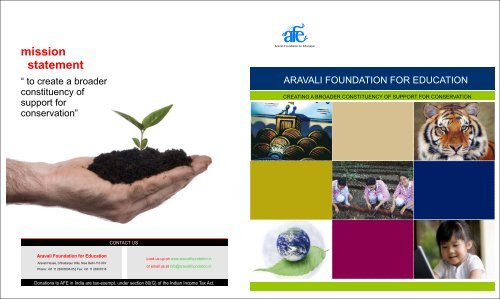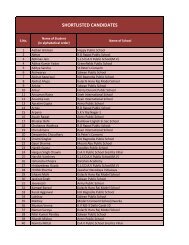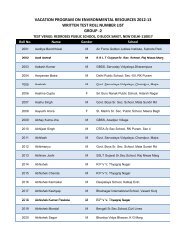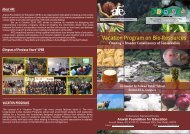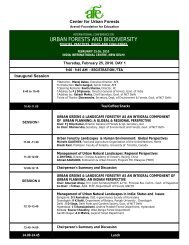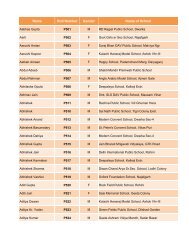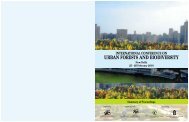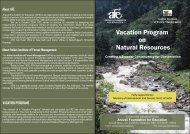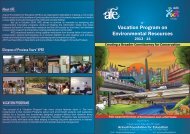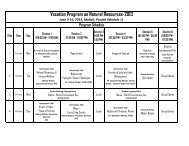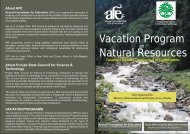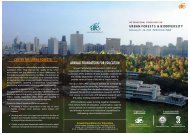mission statement - Aravali Foundation for Education
mission statement - Aravali Foundation for Education
mission statement - Aravali Foundation for Education
- No tags were found...
Create successful ePaper yourself
Turn your PDF publications into a flip-book with our unique Google optimized e-Paper software.
<strong>mission</strong><strong>statement</strong>“ to create a broaderconstituency ofsupport <strong>for</strong>conservation”<strong>Aravali</strong> <strong>Foundation</strong> <strong>for</strong> <strong>Education</strong>ARAVALI FOUNDATION FOR EDUCATIONCREATING A BROADER CONSTITUENCY OF SUPPORT FOR CONSERVATIONCONTACT US<strong>Aravali</strong> <strong>Foundation</strong> <strong>for</strong> <strong>Education</strong><strong>Aravali</strong> House, Chhattarpur Hills, New Delhi-110 074Phone: +91 11 26303504-05 | Fax: +91 11 26301016Look us up on www.aravalifoundation.inor email us at info@aravalifoundation.inDonations to AFE in India are tax-exempt, under section 80(G) of the Indian Income Tax Act.
Report: 2007-2010contentsFrom The Director’s DeskConservation <strong>Education</strong>World without WallsVacation ProgramsVacation Program on Natural ResourcesVacation Program on BioresourcesVacation Program on Environmental ResourcesThe DNA Clubs ProgramProgram Management Unit (DNA Clubs Program)Communication and OutreachNatural Resource and Climate ChangeCenter <strong>for</strong> Urban ForestsInternational Conference on Urban Forests and BiodiversityGovernanceCollaborators and PartnersFinancial Statement478121314151618202425262829302 3
From the Director’s DeskIt is now clear that the battle <strong>for</strong> conservationof nature and natural resources will have to befought not in laboratories or in corridors ofpower, but in the hearts and minds of people.Apathy of general populace towards long termimplications of continued degradation ofnature can undo all the possibilities madeavailable by science and policy analysis.Even while there is virtually no disagreementon the need to engage the civil society in thedialogue and debate on conservation issues, itis a fact that our R&D institutions continue tooperate like islands of excellence in oceans ofignorance.This situation is largely the result of the factthat <strong>for</strong> most individuals there is moreexcitement and fame in “creating” newknowledge than disseminating the wisdomthat already exists and making it work on theground. It is <strong>for</strong> this reason outreach takes aback seat in most of our R&D institutionsleaving a civil society that is often ignorantabout the significance and import of ef<strong>for</strong>tsand initiatives undertaken by such institutions.Recognising the need to have institutions thatfocus on bridging this in<strong>for</strong>mation divide andlink conservation science with humanconsciousness, <strong>Aravali</strong> <strong>Foundation</strong> <strong>for</strong><strong>Education</strong> (AFE) was set up in October,2004 with an objective to create a coreconstituency of support <strong>for</strong> ef<strong>for</strong>ts in thefield of conservation of natural resources,and, improvement in human habitats. It isobvious that two main objectives of AFEare inseparably interlinked.AFE strongly believes in the idea ofworking through synergistic alliancesresting on the commonality of purposebetween institutions in various sectorsand/or geographical settings. AFEproactively seeks to bring togetherinstitutions from diverse fields ofeducation, conservation, science andbusiness on a common plat<strong>for</strong>m to worktogether and enhance human andinstitutional capabilities <strong>for</strong> addressingenvironmental concerns.Program implementation at AFE benefitsimmensely from the synergy of past as wellcurrent partnerships. This emphasis onbuilding bridges with other institutions enablesAFE to go well past its own "in-house"capacities in pursuit of its mandate.Ef<strong>for</strong>ts of AFE are organised under threedistinct yet interlinked divisions which supporteach other to achieve sectoral and/or commongoals. Each division is headed by a Directorlevel person who is supported by a competentteam of professionals at various levels.In its <strong>for</strong>mative years, AFE has strived <strong>for</strong> andsucceeded in creating a niche <strong>for</strong> itself bydesigning and implementing innovative andexciting programs that aim at enhancing theappreciation <strong>for</strong> things natural amongst schoolstudents. AFE has very successfullycollaborated with other institutions working inthe field of science and /or conservation tohelp them improve their outreach ef<strong>for</strong>ts andlink better with the constituencies they wish toserve. With stable and sought after offerings inthe field of conservation education andcommunication & outreach, AFE recently tookup the cause of urban <strong>for</strong>ests as madeimperative by emerging developmentaltrajectory of India.As AFE moves towards maturity in its ongoinginitiatives, I, on behalf of my colleagues atAFE and members of AFE's Executive Board,would like to thank all organizations andindividuals who have supported andencouraged AFE on its slow, but steadyjourney till date, towards becoming aninstitution that is valued by the society <strong>for</strong> itscontributions rather than <strong>for</strong> its size.Manoj DabasExecutive Director<strong>Aravali</strong> <strong>Foundation</strong> <strong>for</strong> <strong>Education</strong>Natural ResourceManagement4 5
Conservation <strong>Education</strong>The gymnasium, the athletic track and aswimming pool are ameliorators of oursynthetic living in a world distorted by WALLS.Walls are not only of brick and mortar, but alsothe ones that we create within our own minds.Nature created a world without walls. A worldwhere a vast sky can snugly fit into two pairs ofeyes and arms, open wide. Where one can learna lot from rocks, rivers and trees. More thanwhat the space with in four walls of aclassroom has to offer. A world where music isnot <strong>for</strong>ced out of an i-pod, but wafts out as asparrow’s chirp, rustle of dry leaves or simplyas the deafening silence of expansive sands. Aworld where time moves slowly, but theimagination runs fast.AFE recognises the fact that the battle <strong>for</strong>conservation of natural resources has to befought and won, not in laboratories orlegislatures, but in the heart and minds ofpeople. It is critical to create a broaderconstituency of support <strong>for</strong> conservationef<strong>for</strong>ts in that direction to succeed. In thiscontext the primacy of young children as atarget group is unquestionable. Withmalleable attitudes and without the excessbaggage of history, children are easily themost adaptive and an increasingly influentialtarget audience <strong>for</strong> conservation educationprograms to focus on.Conservation <strong>Education</strong> and Training Divisionat the <strong>Aravali</strong> <strong>Foundation</strong> <strong>for</strong> <strong>Education</strong> has itsef<strong>for</strong>ts focused on strengthening the linkagesbetween <strong>for</strong>mal school education andconservation of natural resources. AFE seeksto achieve its mandate through developingprograms that help the younger generation toconnect with the realities of nature and alsoget them exposed to cutting edge sciencebeing deployed to tackle environmentalchallenges.AFE's well diversified portfolio of programsand activities in the field of Conservation<strong>Education</strong> is designed to cater to the broadspectrum of capacity building needs of schoolstudents and school teachers. To achieve itsgoals and design exciting conservationeducation programs, AFE collaborates with awide range of agencies and institutionsengaged in R&D and/or management ofnatural resources.6 7
World without WallsWorld without Walls, AFE's flagshipinitiative in the area of conservationeducation, engages young students withrealities of nature through structuredthematic outdoor learning modules namelyThe Mountain Program and The DesertProgram. The primary objective of Worldwithout Walls is to establish an enrichinglink between limited perspectives of youngstudents and the limitlessness of thenatural world.In operation since the year 2002,World without Walls has, over time, evolvedas one of the most popular nature learningprograms available to school students inthe National Capital Region. The modulesoffered under World without Walls compriseof learning outback excursions, freewheelinginteractions with members of localcommunities and a wide variety of excitingin-camp activities that offer an opportunityto have fun even as one learns aboutmyriad aspects of the natural world.More than 1200 students, fromdiverse socio-economic backgrounds,participate every year in training modules ofvarying durations (3 days or more)organised at dedicated campusesdeveloped <strong>for</strong> the purpose in HimachalPradesh and Rajasthan, by AFE.Steps are now being taken to designand launch The Marine Program in thewinter of 2011.Camp ChurdharRajgarh, Sirmaur, (H.P.)Camp AlpineSairopa, KULLU (H.P.)Mountains are crucial to all life on Earth. Though home to only 12 percent of the world's humanpopulation, mountains have influenced the lifestyles of a much larger proportion of humanity.Mountains are also one of the most densely <strong>for</strong>ested regions of Earth, making them uniqueecosystems providing habitat to a wide variety of plants and animals. Mountains do matter. Andone way or the other, we are all mountain people.The Mountain Learning Program at the <strong>Aravali</strong> <strong>Foundation</strong> <strong>for</strong> <strong>Education</strong> (AFE) strives toexpose young minds to the realities, rigors and excitement of a life in the mountains. It alsoseeks to enable them to discover, experience, understand and enjoy the incredible naturalrealities of the mountains. After all, to learn more about the mountains is like learning moreabout our own self.Time spent in the mountains is not necessarily a break away from learning. It can actually be awonderfully different way to learn. Learning that comes naturally by linking concepts dealtupon within the four walls of the classroom with the realities of nature.The Mountain Learning Program is operated out of AFE's dedicated facilities developed underits World Without Walls program based at Kullu and Sirmaur districts in Himachal Pradesh.2Deserts cover about 1/5 of the Earth's surface, and continue to expand. Spread over an area of approximately 200,000 Km , Thar Desert is the largest arid landscapein India. Expansion of the Thar poses a serious threat to the surrounding agriculturally fertile regions, particularly the flood plains of Indus and Ganga river basins. And<strong>for</strong> the Thar, even Delhi is not too far. Halting this relentless march of the sands is a daunting challenge. Challenges apart, deserts are unique ecosystems and theirbeautiful landscapes have cradled some of the most diverse and versatile human cultures. It is no surprise that <strong>for</strong> those living in a desert, material valour and humancompassion are just two sides of the same coin. Thar, also called the Great Indian Desert, is no exception. The Desert Learning Program seeks to bring young studentsface to face with the rugged beauty, rich culture and tough realities of a desert. It strives to expose its participants to the physical and intellectual challenges posed bydeserts while also respecting their personal limits.The Desert Learning Program is conducted by the <strong>Aravali</strong> foundation <strong>for</strong> <strong>Education</strong> (AFE) in collaboration with partner organizations at Jodhpur, Rajasthan.8 9
American Embassy School*Amity International School, Noida*Amity International School, SaketAmity International School, Sector 43, Gurgaon*Amity International School, Sector 46, Gurgaon*Amity International School, Pushp ViharAmity International School, Mayur Vihar*Amity International School, GaziabadBanyan Tree School, Lodi Road*Bloom Public School, Vasant KunjDelhi Public School, DwarkaDelhi Public School, Mathura Road*Delhi Public School, R K PuramDelhi Public School, Vasant KunjDelhi Public School, Gurgaon*Gyan Bharati School, SaketG.D Goenka Public School, Dwarka:Partner SchoolsHillwoods Academy, Preet ViharIndian School, Sadiq Nagar*Loreto Convent, Delhi Cantt.*Presentation Convent, SP MargRamjas School, R. K. PuramRed Roses Public School, SaketSalwan Public School, DelhiSalwan Public School, Gurgaon*Sanskriti School, Chanakya Puri*Sardar Patel School, Lodi Road*Shri Ram School, GurgaonSummerfield School, Kailash ColonySt. Columba’s, Gole Market*St. Mary’s School, Safdarjung EnclaveVidya Niketan School, SaketShannen Eikerman, American Embassy School, Chanakyapuri, New DelhiWorld without Walls mini-course provided me and my classmates with an un<strong>for</strong>gettable experience. Ifweaving baskets with local artisans was fun, working in the local farm <strong>for</strong> half a day told how tough thelife is <strong>for</strong> those tilling those terraced fields. The simple fact that the course made us “do” things ratherthan “see” them makes it so different from other places I have been be<strong>for</strong>e. It was indeed a unusualexperience that enabled us to discover the beauty of India outside of its cities. I will miss the campsitefood as well.Days spent at Camp Churdhar was not a break from learning as I would have imagined. It was in facta different way to learn different things.Suman ChopraTeacher, Loreto Convent School, DelhiCurriculum of modules under theWorld without Walls program is avery well designed experientiallearning program that uses theinnate curiosity of a young mind asa tool to convey the message.Observing and questioning takesprecedence over listening andmemorising and field observationsare effectively linked what is taughtin the classrooms making it directly relevant.Reena NagrathPrincipal, DAV School, AmbalaBy encouraging our students toattend the programs under theWorld without Walls initiativeAFE has allowed us to convertschool excursions into genuinelearning experiences. World withWalls very successively clubsserious learning with excitingoutdoor fun. The feedback fromstudents who have been on theprogram is very encouraging.* : Schools that have participated more than once.Shivansh Mudgil,Amity InternationalSchool, New DelhiMy participation inThe MountainProgram at CampAlpine was a chanceevent but I waspleased that I went<strong>for</strong> it.For the first time in my life I spent afulll day in a mountain which openedmy eyes to several realities of the lifein the mountains that I was obliviousof while living in the city. Trek throughthe Great Himalayan National Parkand learning about medicinal plantswas great. And the icing on the cakewere fishing trout in the gushingwaters of river Tirthan. Would like toback soon.Sudipta Pathak, Salwan Public School, GurgaonParticipating in World without Walls opened my eyes to thecritical contributions that mountains make to our lives in citiesfar beyond. It was therapeutic indeed to see the conservationef<strong>for</strong>ts being carried out by various agencies with support oflocal communities. I am now able to better appreciate the rolesuch ef<strong>for</strong>ts in the mountains play in my own welfare. And yes,the Camp Alpine at Kullu was just awesome <strong>for</strong> the river runningnext to it.Nidan, St Columba's School, New DelhiDays spent at Camp Churdhar helped me connect with a worldreally without walls. While the treks were tiring indeed, I find ithumbling that such long hauls are a part of the daily grind <strong>for</strong>people in the hills. Night trek in <strong>for</strong>est made me learn how scarythe darkness of the jungle can be. Spending a day with thefriendly and hospitable villagers of Rooh Bhagota was a greatlearning experience as what are basic necessities in our citiesoften pass as luxuries out here. And the variety of corn, in justone village, was mind boggling. Would like to get back soon!10 11
Vacation ProgramsAFE recognizes the need to identify andnurture future leadership in the field ofenvironment and conservation of naturalresources. It is clear to AFE that like otherdomains, in the field of environment too, theedifice of leadership cannot be built withoutlaying a strong foundation of knowledgeabout and understanding of environmentalconcerns and issues.In order to enlarge the pool of talentavailable in the future to take upenvironmental causes, AFE organizesVacation Programs on various aspects ofenvironmental management andconservation. Vacation Programs are upto 4weeks in duration, fully residential andcomprise a mix of classroom sessions,hands-on activities, exposure visits toinstitutions of excellence and mini-projects.The uniqueness of the Vacation Program isthe way its various components areseamlessly integrated with each other tohelp its participants develop a largerperspective that links environment with theirthoughts and decision making in the day today lives. By exposing the participants toinstitutions and individuals at the cuttingedge of ef<strong>for</strong>ts in natural resourcemanagement, Vacation Programs inspireand prepare its participants to assumeleadership positions in activities aimed atconservation of natural resources, in thetimes to come.Vacation Program on Natural ResourcesVacation Program on Natural Resources (VPNR) is an initiative aimed at creating a broaderconstituency of support <strong>for</strong> conservation of natural resources by creating a core of young citizenswho are conscious of the conservation challenges faced by India as it emerges as an economicpower in the new global order.To create leadership in the field of environment in thefuture it is necessary that young students with distinctleadership qualities are identified and exposed toconservation issues and challenges early in their lives.For a ecologically secure future it is necessary that GenNext is allowed a sneak preview of the nations resolveto deal with its environmental challenges and co-optthem as stakeholders in the same.In collaboration withMinistry of Environment and ForestsGovernment of IndiaVPNR is small but sure step in that direction by AFE. Aunique initiative that has been supported by Ministry ofEnvironment and Forests since 2002, VPNR is an annual 4 week residential program held atdifferent city each year (see table below). The program has 40 participants carefully selected tobalance gender, economic and regional considerations. The curriculum of the programs of aunique mix of outdoor learning excursions, interaction with experts and field activists of eminence,hands on activities & mini-projects, audio-visual shows and visits to institutions of excellence inthe field of conservation.VPNR innovatively links a number of institutions with implementation of various components ofthe program making it a truly inter-institutional initiative. Alumni of VPNR’s conducted till dateexceeds 500 and is a vibrant interactive community.Year200520062007Vacation Program Natural ResourcesBrief HistoryPlace/StateDelhi I National Capital RegionKalimpong I West BengalDehradun I UttaranchalPartner InstitutionNational Museum of Natural History, New DelhiAshoka Trust <strong>for</strong> Research in Ecology And theEnvironment, DarjeelingIndira Gandhi National Forest Academy, Dehradun200820092010Lucknow I Uttar PradeshKarnal I HaryanaBhopal l Madhya PradeshNational Bureau of Fish Genetic Resources, LucknowNational Dairy Research Institute, KarnalIndian Institute of Forest Management, Bhopal12 13
Vacation Program on BioresourcesVacation Program on Environmental ResourcesBioresources <strong>for</strong>m the bedrock on whichrests the human existence on earth. Fromfuel to food, fibre to medicine, bioresourcesare inseparably welded to every aspect ofhuman life. On one hand, science has vastlyempowered the human society to usebioresources in an unprecedented mannerand scale to enhance its welfare. On theother hand, it has led to over-exploitation ofbioresources to the extent that sustainabilityseems to be a <strong>for</strong>gotten word. Sustainingbioresource base and sustaining humanexistence are indeed two sides of the samecoin.Vacation Program on Bioresources (VPBR)is organized each year by AFE, with supportfrom Department of Biotechnology,Government of India. VPBR is designed tohighlight the linkages between sustainabilityof bioresources with long-term human welfareas well as the role that science is playing, and can potentially play, in helping mankind to augmentthe utility and sustainability of earth's bioresources.Similar to VPNR in its structure, <strong>for</strong>mat and targetaudience, VPBR places a heavier emphasis on the roleand interface of science with management of bioresources.60 participants of the program are selectedfrom schools in Delhi and Haryana through an openselection process. VPBR is organized under the aegis ofthe DNA CLUBS Program, the flagship school outreachinitiative of the Department of Biotechnology, Government of India.In collaboration withA larger proportion of India's population isgoing to live in cities in the times to come.Management of environmental issues inurban habitats is acquiring increasing andunprecedented urgency. National CapitalRegion, of which Delhi is the predominantpart, is no exception.AFE and Department of Environment,Govt. of Delhi have collaborated <strong>for</strong> thepast seven years to annually conduct theVacation Program on EnvironmentalResources (VPER). Aimed at Class 8 & 9students enrolled in Eco-Clubs constitutedby Department of Environment, Govt. ofNCT of Delhi in more than 2000 schools ofDelhi, VPER is the only program of its kindin Delhi.Unlike other Vacation Programs conductedby AFE, VPER is a 2 week non residential program strikes a fine balance between in classinstruction and first hand exposure. Due to its innovative design and professional implementation,VPER has carved a niche <strong>for</strong> itself in annual calendar of events followed by schools in Delhi. Thisis evident from the more than 2000 applications receivedIn collaboration with each year <strong>for</strong> the limited 80 seats offered under theprogram. The selection is done through a two tierprocess involving a written test and group discussionexercise (only <strong>for</strong> short listed candidates).Department of EnvironmentGovt. of NCT Delhisince they were initiated in Year 2002.More than 800 students have been through VPER’s14 15
The DNA Clubs ProgramBioresources <strong>for</strong>m the bedrock on which the edifice of human civilisation ultimately rests. For humanityto sustain its existence on earth, it is necessary that not only the significance of bioresources is wellunderstood but the actions are geared in amanner that leads to sustainable managementand conservation of bioresources.The DNA CLUBS (DBT's Natural ResourceAwareness Clubs) Program, the flagshipschool outreach program of the Department ofBiotechnology, Government of India, seeks toseamlessly integrate with the <strong>for</strong>mal school curriculum, a set of round the year activities aimed atgiving young students a comprehensive exposure to, and an overview of, the fascinating world ofbioresources. Formally constituted DNA Clubs in each partner school act as a special purpose vehicleto plan and implement various activities envisaged under the program. The program in each school iscoordinated by a designated school coordinator.More than 20,000 young students, as members of specially constituted DNA Clubs in 190 schoolsspread across 20 states of India, are now involved in exploring the magnificent world of Bioresourcesand understanding how human welfare derives strength from sustainable utilisation ofbioresources.AFE has been per<strong>for</strong>ming the roleof the designated RegionalResource Agency <strong>for</strong> the states ofDelhi and Haryana to coordinateand facilitate the implementationof activities envisaged under theDNA Clubs program. AFE workswith 20 “Partner Schools” cateringto educational needs of childrenfrom diverse socio-economicbackgrounds.DNA Clubs Program: Partner SchoolsDelhiKendriya Vidyalaya , J N U CampusKendriya Vidyalaya, A F S, TughlakabadKendriya Vidyalaya No.3, Delhi CanttDayanand Anglo Vedic Public school, Shrestha ViharDelhi Public School, DwarkaJawahar Navodaya Vidyalaya, JaffarpurkalanGyan Bharati School, SaketThe Banyan Tree School, Lodi RoadLoreto Convent School, Parade RoadSanskriti Public School, Chanakya puriHaryanaKendriya Vidyalaya -1, FaridabadKendriya Vidyalaya -2, Ambala CanttKendriya Vidyalaya, NSG Manesar, GurgaonDayanand Anglo Vedic Sr. Sec. School KurukshetraMurli Dhar DAV Sr. Sec. School, Ambala CityDelhi Public School, Gurgaon,Salwan Public School, GurgaonGita Niketan Awasiya Vidyalaya, KurukshetraMukand Lal Public School, Yamuna NagarAmity International School ,Sec -46, GurgaonActivities Lectures by invited experts onselected topics Visits to premier scientificinstitutions <strong>for</strong> a first handexposure to cutting edgetechnology and research ef<strong>for</strong>ts <strong>Education</strong>al excursions to fieldlocations having significantlearning takeaways from abioresources perspective. Laboratory experiments andhands-on activities on bioresourcethemes inside andoutside the school Audio-Visual presentations andfilm screenings on issuesrelevant to management ofbioresources Intra & Inter School competitionson Bio-resource Themes Vacation Training ProgramsperMUTATIONS, now an annualevent, enables members of DNAClubs across the states of Delhiand Haryana to showcase theiref<strong>for</strong>ts under the DNA Clubsprogram as well as test their skillsby participating in competitionsorganised on themes related toBioresources.Spread over 3 days,perMUTATIONS attractsparticipation of about 500 studentsand 50 teachers from partnerschools. Apart from injecting a spiritof healthy competition in theprogram, it also provides membersof the DNA Clubs community aunique opportunity to interact, bondand learn from each other.16 17
Program Management Unit (DNA Clubs Program)DNA Clubs Program ( www.dnaclubs.org), the flagship school outreachprogram of the Department of Biotechnology, Government of India isbeing implemented in more than 600 schools spread across 20 statesof India directly involving more than 36000 students as membersof DNA Clubs specially constituted partner schools. The programis facilitated by 12 reputed institutionsidentified as Regional ResourceAgencies (RRAs) with specific areas ofresponbility (see map and table).In order to coordinate, facilitate anddocument the activities of the DNA ClubsProgram, a dedicated Program ManagementUnit has been set by the Department ofBiotechnology at AFE, New Delhi.With a dedicated professional acting asCoordinator, PMU not only works with RRAs toensure a smooth implementation of the programbut also acts as a link between RRAs and DBT. Adedicated website <strong>for</strong> the DNA Clubs program hasbeen set up by the PMU to link various stakeholdersin the program together. A national event at New Delhiis planned to allow members of DNA Clubs across thecountry to showcase their ef<strong>for</strong>ts and get an opportunityto interact with each other.S.no. Regional Resource Agencies States Covered123456789101112<strong>Aravali</strong> <strong>Foundation</strong> <strong>for</strong> <strong>Education</strong>(AFE), New DelhiAshoka Trust <strong>for</strong> Research in Ecology & Environment (ATREE), BangaloreBharati Vidyapeeth Institute of Environment <strong>Education</strong> and Research (BVIEER), PuneCentre <strong>for</strong> Biodiversity Studies, Baba Ghulam Shah University (CBS), RajouriGujarat Council of Science City (GCSC), AhmedabadInstitute of Bio-resources and Sustainable Development (IBSD), ImphalLoyola Institute of Frontier Energy (LIFE), ChennaiShri AMM Murugappa Chettiar Research Centre (MCRC), ChennaiM.S. Swaminathan Research <strong>Foundation</strong> (MSSRF), ChennaiNational Academy of Sciences, India (NASI), AllahabadSalim Ali Centre <strong>for</strong> Ornithology and Natural History (SACON), Tamil NaduThe Energy and Resources Institute (TERI), GuwahatiDelhi & HaryanaKarnatakaMaharashtra & GoaJammu & KashmirGujaratSikkim & ManipurTamil NaduPuducherryOrissa & KeralaUttar Pradesh, Madhya Pradesh & BiharAndaman & Nicobar IslandsAssam, Tripura and Meghalaya1819
Communication and OutreachAFE recognises thatcommunication and outreachef<strong>for</strong>ts do not receive as muchemphasis in most Indianinstitutions associated withmanagement of natural resources.This is either due to a lack ofappreciation of the importance ofeffective outreach communicationor due to lack of in-house humantalent with skills required <strong>for</strong>effective outreach planning anddelivery, or both. Inadequateoutreach and communicationef<strong>for</strong>ts lead to inadequateappreciation of the role andimportance of work done by theorganisations concerned amongstthe civil society.AFE also makes available its inhousestrengths in the area ofcommunications to a wide varietyof organisations to help themdesign outreach strategies andimplement them in a focusedmanner while ensuring quality ofcontent and its presentation.AFE’s assistance is viewed as a<strong>for</strong>ce multiplier by beneficiary asthey enhance the effectiveness ofconservation initiatives of otherorganisations by helping themsecure the attention andcooperation of their targetaudience.<strong>Education</strong>al Campaign on GlobalWarmingAFE designed an educational poster on GlobalWarming with support from the Ministry ofEnvironment and Forests, Govt. of India (MoEF).Based on the feedback recieved, 100,000 copiesof the posters were printed and distributed to asmany schools covered by MoEF’s National GreenCorps Program across the country. The posterwas <strong>for</strong>mally released by Shri Pranab Mukerjee,then Defence Minister of India on June 5, 2008 tomark the World Environment Day at New Delhi.(L-R) Ms. Meena Gupta, Secretary (Ministry of Environment & Forests, Govt. of India), Mr. S Regupathy, MOS (Environment & Forests, Govt. of India)Shri Pranab Mukerjee, Defence Minister, Govt. of India, Mr. Namo Narayan Meena, MOS (Environment & Forests, Govt. of India),Mr. S Behura, Special Secretary (Environment, Govt. of India)Focusing on MangrovesCoastal areas are critical to human welfare <strong>for</strong> the simple reason thatthey not only support livelihoods of a vast proportion of humanpopulation on earth, they are also repositories of a significant level ofbiodiversity as we know it. With rapid growth in human population andindustrialisation, coastal ecosystems face unprecedented threats to theirsustainability and viability. This is a trend that needs to be immediatelystemmed, and soon reversed. Creating awareness on conservationchallenges in coastal areas is the first step in this direction.IUCN-India and AFE have now agreed to collaborate to bring out aseries of publications on coastal and mangrove ecosystems.Creating Awareness on Issues andChallenges in the Water SectorAFE and Institute of Rural Research andDevelopment (IRRAD), Gurgaon havecollaborated to create and disseminate anin<strong>for</strong>mation package on issues and challenges inthe water sector. The in<strong>for</strong>mation package shallcomprise of four educational posters, a CDbased multimedia presentation and amonograph giving a comprehensive overview onissues and challenges associated with water inan Indian context.20 21
PeriodicalsApart from working on in-house outreach materials, Communication and Outreach Division at AFEalso produces and publishes Biotech News, the official newsletter of Department ofBiotechnology, Government of India, and CONNECT, the official newsletter of the Indo-USScience and Technology Forum, New Delhi.Published once every two months,Biotech News has emerged as abenchmark in the newslettercategory of publications. With a printrun of 20,000 copies per issue,Biotech News reaches out to all partsof the country. It can be electronicallydownloaded free of cost fromwww.biotechnews.co.in‘The great aim of education is notknowledge but action.Herbert SpencerCONNECT showcases thecollaborative ef<strong>for</strong>ts of Indian andAmerican individuals/institutions inthe area of science and technology.With a print run of 1000 copies andan e-version available <strong>for</strong> free,CONNECT has fast evolved as aniche publication of quality andrepute in the field of Science &Technology.22
Natural Resource ManagementCenter For Urban ForestsHumankind’s ability to conserve earth’s naturalresources will determine whether this planet willcontinue to be a viable human habitat or not inthe times to come. And the day of reckoningmay not be as far as it may have appeared afew decades ago.As human society evolved, the nature of issuesof challenges in the domain of natural resourcemanagement has undergone a change in itscomposition. While old challenges haveaggravated, new ones have emerged.Urbanisation is one phenomenon that isbeginning to move towards the center stage ofdialogue on conservation. AFE recognizes thaturban environmental problems will need everincreasing focus in the times to come. Thestraight <strong>for</strong>ward reason <strong>for</strong> this is the rapidlyincreasing size of our cities and towns and anever increasing human population migrating tothese habitations in search of professionalopportunities. As cities grow, their ecologicalfootprint rapidly enlarges even as they becomemore and more vulnerable to naturaldisturbances and imbalances, includingclimate change.Natural Resource and Climate ChangeDivision at AFE focuses on identifying andanalyzing the drivers of urban environmentaldecline, and seeks to work with city managersand urban planning agencies in finding waysand means to enhance the extent and efficacyof urban green spaces, including urban <strong>for</strong>ests.AFE strives to achieve these objectives by notonly promoting an exchange of in<strong>for</strong>mation andregular dialogue between various stakeholdersin urban management, but also by undertakingpilot programs to demonstrate technologiesand practices relevant to urban environmentalmanagement.Urban <strong>for</strong>ests play a fundamentally important role inbuilding ecological cities. They improve theenvironmental quality of the urban environment andthe aesthetics of urban landscapes. In manydeveloped and developing countries, the evolution ofurban <strong>for</strong>estry has been recognized as an essentialmeans of maintaining urban ecosystem health,improving human living conditions, fostering aharmonious human-nature relationship, andultimately achieving urban sustainability. Specifically,trees help conserve energy, remove atmosphericcarbon, reduce stormwater runoff and increase valueof proximal real estate.Urbanization in Asia has been growing at a rapidrate and is expected to accelerate in the future. It is<strong>for</strong>ecast that 17 out of 27 world's largest mega-citieswill be in Asia by 2015.As India urbanizes rapidly, there is an urgent need torecognize and fully exploit the potential of urban<strong>for</strong>estry and <strong>for</strong>ests to improve the quality of life <strong>for</strong>those who live in India's fast expanding cities.Today, 310 million people live in India's cities.By 2030, this number will be 575 million. By 2045,800 million!Every minute, 30 Indians leave rural India <strong>for</strong> itscities!!Most Indian cities are filled to the brim. In someareas, Mumbai has almost 100,000 people packed intoevery square kilometer!!!What that does to the environment and quality oflife is anybody’s guess.It is now recognised that the spatial, recreational,educational and ecological potential of urban<strong>for</strong>estry has not been fully utilized in Indian cities.Center <strong>for</strong> Urban Forests at AFE seeks to integrateurban <strong>for</strong>estry seamlessly with urban planning andalso to improve management of urban <strong>for</strong>ests inorder to fully tap their potential <strong>for</strong> general welfareand better quality of life in a sustainable manner.2425
INTERNATIONAL CONFERENCE ONURBAN FORESTS & BIODIVERSITYAFE organized the International Conference onUrban Forests and Biodiversity. Theconference was held at New Delhi on February25-26, 2010 in collaboration with Delhi Parksand Gardens Society, Govt. of NCT Delhi andthe India International Center, New Delhi. Themeeting was also supported by Ministry ofScience and Technology, Govt. of India andMinistry of Environment and Forests, Govt. ofIndia.academicians, civil society representatives,bilateral and multilateral donor agencies.The conference stimulated a productive highlevelexchange of ideas and perspectives onthe subject of Urban Forests and Biodiversity.The participants explored and examined thestrategies and tools available and their possibleapplications to develop healthy urbanenvironments and local economies.Quantifying benefits of urban green spacesUrban green spaces often compete with other alternativelanduses during the course of city planning anddevelopment. While benefits of civil projects can be easilyquantified, most of the benefits of benefits get clubbed inthe “intangible” category and are seldom appreciated intotality.In order demonstrate how better valuation of a city’s greenassets can impact decision making processes in urbanplanning, AFE and New Delhi Municipal Council havejoined hands to conduct a pilot study using speciallydesigned software to quantify the contribution of urbangreen spaces in reducing the carbon footprint of cities.The specific objective(s) of the pilot study are:A) Analyse <strong>for</strong>est structure and quantify value of benefitsyielded by trees in a specified area of city of Delhi usingspecially developed software (I-Tree Eco).B) Use and validate a software tool (I-Tree Eco) in order tomake it widely useable in other parts of the country <strong>for</strong>similar studies.C) Make available the results of the study to policy makersin order to highlight the underestimation of value of greenspaces.The expected date of conclusion of the project is April, 2011.Baseline study on Urban ForestsUrban <strong>for</strong>estry is neither a recognized discipline in India,nor the country has a national policy on how the <strong>for</strong>ests andother green spaces in urban areas are to be managed. As aresult, urban <strong>for</strong>estry practices have evolved in unique waysin different cities, in response to administrative, historical,climatic, demographic and social-cultural factors.In response to the knowledge/in<strong>for</strong>mation gaps that exist inIndia in the context of urban <strong>for</strong>ests, CUF, AFE haslaunched an initiative with the following objectives:A) Collect baseline data on various aspects of urban <strong>for</strong>estsand green spaces from Indian citiesB) Study and compare the management systems andinstitutional arrangements employed to create/manageurban <strong>for</strong>ests and green spaces in Indian cities.The cities to be covered by the study in Phase 1 are : Delhi,Chandigarh, Ahemdabad-Gandhi Nagar, Mumbai,Hyderabad-Secunderabad, Bengaluru, Chennai andKolkata. The selection of the cities has been made keepingin mind the diversity of urban settings in India.The study is proposed to be published in the <strong>for</strong>m of a bookproposed to released in April, 2011.Dr. P.J. Dilip Kumar, IFSDirector General of Forests, Govt. of India,delivering the keynote addressMs. Sheila Dixit, Chief Minister of Delhi,delivering the valedictory addressMr. Rakesh Mehta, IASChief Secretary, Govt. of NCT Delhi,giving the inaugural addressThe main objectives of the conference were toa) review the progress and status of urban andperi-urban <strong>for</strong>est development in an Indiancontext; b) exchange in<strong>for</strong>mation, ideas and tolearn from each other about management ofurban <strong>for</strong>ests and c) establish networkingamong participants <strong>for</strong> a sustained dialogueand concomitant action on issues related tourban <strong>for</strong>ests.The conference brought together more than100 experts/practitioners from agencies andinstitutions in India and other countries aroundthe world which included urban planners andmanagers, policy makers, urban <strong>for</strong>esters,The conference also helped AFE to determinethe agenda of the Center <strong>for</strong> Urban Forests(CUF) set up at AFE <strong>for</strong> raising the profile ofurban <strong>for</strong>estry as a discipline in India throughresearch and facilitating productiveexchange(s) of ideas on the subject.AFE is now working to convert the roadmapdeveloped <strong>for</strong> CUF into programs andactivities.Please visit www.aravalifoundation.in todownload summary of proceedings and list ofparticipants.26 27
Program Advisory BoardCollaborators and PartnersBarin Ganguli Ph.DFormer Lead Specialist,Asian Development Bank, ManilaDhirendra SinghFormer Secretary,Ministry of Home AffairsGovernment of IndiaMs. Amarjeet Kaur AhujaFormer Additional Chief Secretary,Government of RajasthanTej P Singh Ph.DDistinguished Biotechnologist,All India Institute of Medical Sciences,New DelhiAlok Bhattacharya Ph.DProfessor,School of Life Sciences,Jawahar Lal Nehru University,New DelhiManoj Dabas (Ex-officio)Executive Director,AFE, New DelhiProdipto Ghosh Ph.DFormer Secretary,Ministry of Environment and ForestsGovernment of India(Ms.) Indu Khetarpal Ph.DPrincipal,Salwan Public School Gurgaon,HaryanaP D JoseAssociate Professor,Indian Institute of Management,BangaloreWazir Singh Lakra Ph.DDirector,National Bureau of Fish Genetic Resources,LucknowT.P. Singh Ph.DRegional Group Head,Ecosystem and Livelihoods, AsiaIUCN Asia Regional Office,Bangkok, ThailandArid Forest Research Institute, JodhpurNational Bureau of Fish Genetic Resources,LucknowNational Bureau of Plant GeneticResources, New DelhiNational Bureau of Animal GeneticResources, KarnalNational Museum of Natural History, NewDelhiNational Zoologiocal Park, New DelhiNational Dairy Research Institute, KarnalIndian Institute of Forest Management,BhopalPanjab University, ChandigarhIndian Agricultural Research Institute, NewDelhiCentral Institute of Soil Salinity Research,KarnalAshoka Trust <strong>for</strong> Research in Ecology andthe Environment, BangaloreIndo US Science and Technology Forum,New DelhiMother Dairy, New DelhiDelhi Jal Board, New DelhiNew Delhi Municipal Council, New DelhiRanbaxy Laboratories Limited, GurgaonIndraprastha Power Generation Limited,New DelhiDirectorate of Wheat Research, KarnalInstitute <strong>for</strong> Vegetable Research, VaranasiCenter <strong>for</strong> DNA Fingerprinting andDiagnostics, HyderabadDepartment of Biotechnology, Govt. of IndiaDepartment of Science and Technology,Govt. of IndiaDepartment of Environment, Govt. of NCTof DelhiDelhi Parks and Gardens SocietyIndia International Center, New DelhiCentral Institute of Fisheries <strong>Education</strong>,MumbaiIUCN IndiaInstitute <strong>for</strong> Rural Research andDevelopment, GurgaonSchool of Life Sciences, JNU, New DelhiCONTACT US<strong>Aravali</strong> <strong>Foundation</strong> <strong>for</strong> <strong>Education</strong><strong>Aravali</strong> House, Chhattarpur Hills, New Delhi-110 074Phone: +91 11 26303504-05 | Fax: +91 11 26301016Look us up on www.aravalifoundation.inor email us at info@aravalifoundation.inDonations to AFE in India are tax-exempt, under section 80(G) of the Indian Income Tax Act.28 29 29
Balance Sheet as on 31st March, 2010Source of Funds As on 31st March 2010 As on 31st March 2009Scholarship Fund 508977.00 524297.00Campus Development Fund 2,500,000.00 750,000.00Income & Expenditure A/c 3,418,250.41 1,221,001.38Current Liabilities & ProvisionSundry Creditors 122,517.00 305,352.00Expenses Payable 292,600.00 396,356.00Unspent Project Receipts 1,092,192.00 1,691,959.00Advances 1,683,102.00 312,000.00Total9,617,638.41 5,200,965.38Application Of FundsFixed Assets 1,659,799.75 1,828,870.75Investments 2,500,000.00Current Assets, Loans & AdvancesSundry Debtors 3,653,140.00 195,040.00Cash & Bank Balances 1,291,572.56 496,345.63FDR With Bank 2,200,000.00Loans & Advance 102,377.10 174,030.00Prepaid Expenses 41,359.00 34,492.00Interest Accured on FDR 81,012.00Tax Deducted at Source 369,390.00 191,175.00Income & Expenditure Account <strong>for</strong>the year ended 31st March, 2010Particulars As on 31-03-2010 As on 31-03-2009IncomeProject Income 18,694,379.00 8,556,328.00Donation and Other Income 52,025.00 73,700.00Dividend & Bank Interest 89,113.42 182,280.38TotalExpenditure18,835,517.42 8,812,308.38Salaries and Staff Cost 4,280,531.70 2,043,137.00Travel 1,073,996.005,14307.00Project and Operating ExpensesDepreciationAmount Set ApartTotal9,151,799.694,529,491.00345,784.00Surplus/(Deficit) <strong>for</strong> the year 2,197,249.03 879,589.38Balance Brought ForwardBalance Carried <strong>for</strong>ward to Balance Sheet381,941.001,750,000.001,221,001.38500,000.0016,638,268.39 7,932,719.00341,412.003,418,250.41 1,221,001.38Total9,617,638.41 5,200,965.3830 31


